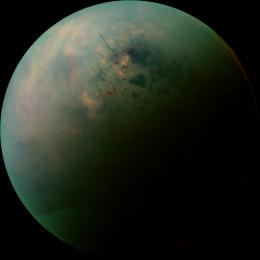
This false-color mosaic, made from infrared data collected by NASA's Cassini spacecraft, reveals the differences in the composition of surface materials around hydrocarbon lakes on Titan, Saturn's largest moon.
Planets are like houses—location is everything. Earth may be fortunate to be drenched with water and rich in the fundamental chemistry of life, but it’s particularly lucky to be orbiting the sun where it does. Much closer to the solar fires and it would be roasted like a nut. Much farther away and it would be flash-frozen—pretty to look at but utterly dead.
Moons are no different—especially the bigger ones, some of which would be respectable planets themselves if they were orbiting the sun on their own. One of the most intriguing of all is Saturn’s Titan, 3,193 miles (5,139 km) across—or nearly half-again bigger than our moon, and bigger still than the planet Mercury. More important, Titan is known to be heavy with hydrocarbons—the primal chemistry of life—especially in the form of methane and ethane. Now NASA‘s Cassini spacecraft, which has been orbiting Saturn since 2004, has revealed another feature of Titan that makes it similar to a biology-friendly planet, and especially similar to Earth: a cluster of Great Lakes in the moon’s northern reaches. And never mind Titan’s frigid -289º F (-179º C) temperature, the lakes are filled sloshing liquid.
Titan has fascinated astronomers ever since its discovery in 1655, when its size and the mere fact that it was there at all caused a sensation. Later, the moon’s color—a bright orange—added to its allure. A color like that in a solar system with the chemical profile of ours suggests organics, and even if nothing could survive in such icy conditions, a close look at Titan might provide sort of a proxy look at the early Earth, when the raw materials for life were there but biology itself had yet to get started. Voyager 1, which reconnoitered Titan in 1980, saw nothing but orange haze, its cameras unable to penetrate the opaque cloud cover. In 1994, however, the Hubble Space Telescope, using near-infrared imagery, was able to discern light and dark patches on Titan’s surface, suggesting the existence of seas and lakes filled with liquid methane and ethane.
(MORE: Most Distant Galaxy Found—and Yes, It’s Far, Far Away)
That theory was at last confirmed when Cassini arrived, sent a small probe parachuting through the Titanian clouds and then began its long tour of the entire Saturnian system. The lakes and seas Cassini mapped were detected mostly with radar, but now the clouds have parted enough for the spacecraft’s visible and infrared cameras to see the surface as it looks and allow the lakes to be counted and studied the old-fashioned way: with human eyes.
The new pictures the spacecraft beamed home were assembled bit by bit during multiple passes by over Titan, during two flybys in July and one in September. And while Cassini had barnstormed that area before, the 30-year transit Saturn and its flock of moons make around the sun mean that seasons change there very slowly, and it’s only now, after nine years on-site, that Cassini can witness the hazy winter in Titan’s northern hemisphere turning to a clearer summer.
“The view from Cassini’s visual and infrared spectrometer gives us a holistic view of an area we’d only seen in bits and pieces before and at a lower resolution,” said Jason Barnes, a researcher participating in the imaging work, in a statement released by NASA. “It turns out that Titan’s north pole is even more interesting than we thought.”
(MORE: Asteroid Pours Water on Dead Sun. Yes, That’s Happening)
Interesting indeed. The region is dotted with lakes, filled with the anticipated methane and ethane, with dry aprons of material around them, suggesting perimeter evaporation similar to what happens at the edges of brackish lakes in the American West. Down here, that drying produces salt flats, but on Titan, the deposits left behind are made of organic chemicals—or compounds that contain carbon, the entry-level requirement for life as we know it. There may be no extant biology on Titan (indeed, there surely isn’t, unless it’s a life form we have yet even to imagine) but the icy world has all the stuff to make it a near-miss, especially where the lakes are.
“Titan’s northern lakes region is one of the most Earth-like and intriguing in the solar system,” say Lisa Spilker, Cassini project scientist.
(MORE: Alone in Space: Free-Foating Planet Discovered)
Relatively clear skies during Titan’s southern summer had revealed something similar at that pole too, but the lakes are far fewer in the south than in the north and Cassini scientists are now trying to figure out why. The best guesses are northern volcanoes that may have left the land pitted and torn and given liquid a place to collect, or surface chemistry peculiar to that region that allows liquids to dissolve bedrock and collect in the depressions left behind.
Life, of course, is the ultimate goal of missions like this—either finding it or understanding its origins better. But lost along the way can be the other phenomena we’re witnessing in the process. Visiting a world with changing seasons, shifting seas, and a three-decade promenade around the sun is no small thing—a tribute both to the richness that is our home solar system and to our improbable ability to go touring it at will.
(MORE: Cloudy With a Chance of Aliens)

